|
|
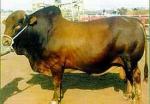
|
Afrikaner
|
|
Afrikaner cattle developed from the native Hottentot cattle of the Cape of Good Hope in South Africa. |
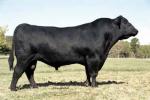
|
Angus
|
|
Angus are solid black cattle, although white may appear on the udder. They are resistant to harsh weather, undemanding, adaptable, good natured, mature extremely early and have a high carcass yield with nicely marbled meat. Angus are renowned as a carcass breed. They are used widely in crossbreeding to improve carcass quality and milking ability. Angus females calve easily and have good calf rearing ability. They are also used as a genetic dehorner as the polled gene is passed on as a dominant characteristic. |
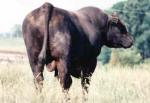
|
Angus Hybrids
|
|
ANGUS HYBRIDS are black polled composite cattle based primarily on the genetics of American Angus blended with enough Continental Breed genetics to add lean red meat performance to the widely acknowledged Angus carcass quality and maternal characteristics. Angus hybrids have demonstrated the ability to pass on hybrid vigor performance to a wide range of cattle breeds including pure bred Angus cattle. |
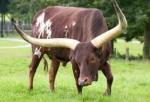
|
Ankole
|
|
Ankole cattle go back many hundreds of years and its ancestry can be traced back to Europe and Asia as early as 15000 BC. Today Ankole cattle are distributed mostly from Lake Mobutu to Lake Tanganyika in eastern Africa. |
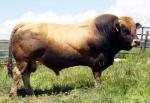
|
Aubrac
|
|
The Aubrac breed is a moderate-framed, highly maternal breed from southern France that was developed centuries ago for production of forage-based beef. |
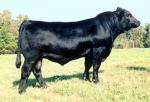
|
Balancer
|
|
Balancers are a hybrid breed created by crossing a purebred Gelbvieh with a purebred Angus. This 50% Gelbvieh - 50% Angus cross combines Gelbvieh's growth, muscle and leanness with Angus's calving ease, moderate size and marbling. |

|
Barzona
|
|
The development of the Barzona began in 1942 when F.N. Bard, an Arizona rancher, decided to develop a breed that would be adapted to their area which was rugged and rocky, with extreme temperatures, sparse rainfall, and scattered feed. He used Hereford, Angus, Afrikander and Santa Gertirudis in more or less equal parts as the basis of the breed. Production records were maintained and a rigid selection was carried out for fertility, rate of gain and mothering ability. |
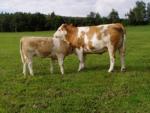
|
Beef simmental
|
|
First imports of Beef Simmental were realised in 1993 from Canada. Other importation followed: from Denmark and Germany. Altogether with heifers were imported also many bulls for breeding. |
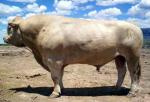
|
Beefalo
|
|
Beefalo is a cross between Bison (buffalo) and domestic or exotic cattle of any breed. The purpose of the species cross was to blend the outstanding qualities of the Bison with outstanding qualities of the bovine breeds of the world. |
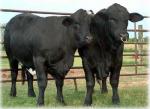
|
Beefmaster
|
|
Beginning in the early 1930s, Tom Lasater, the breed's founder, developed Beefmasters by crossing Hereford, Shorthorn and Brahman cattle. The exact mixture of the foundation cattle is not known, but is thought to be about 25% Hereford, 25% Shorthorn and 50% Brahman. Lasater's purpose was to develop cattle that would be more productive than existing breeds in the harsh environment of South Texas. The cattle were heavily selected on what has become known as the Six Essentials - Weight, Conformation, Milking Ability, Fertility, Hardiness and Disposition. |
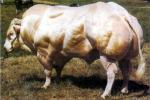
|
Belgian Blue
|
|
Belgian Blues are medium sized, heavy cattle, sometimes with a massive double muscle structure. Their colors are blue, white, and blue and white. Belgian Blues are small boned with a sloping rump, hidden hips, strong legs and a relatively small head. They are quite robust and healthy. |
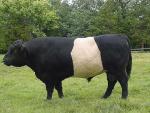
|
Belted Galloway
|
|
The 'Belties', like six other color variants, presumably originated centuries ago from the pure black Galloway. They were mentioned as early as the start of the 19th century. |
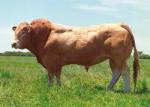
|
Blonde d'Aquitaine
|
|
The Blonde d'Aquitaine breed originated in the Garonne valley and the Pyrenees mountains area in the Aquitaine district of France. |
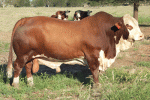
|
Braford
|
|
Alto Adams Jr. began developing Brafords on his Florida ranch in 1947. He began experimenting with various types of Brahman-Hereford cross bulls. Eventually he identified Braford bulls that were producing calves that met his needs and he used these bulls and their offspring to form what is recognized as the Foundation Herd of the Braford breed in the United States. |
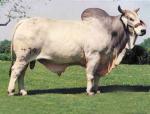
|
Brahman
|
|
Brahman are easily identified by the hump on their back and long floppy ears. The most common colors are solid gray or solid red. The Brahman breed originated from Bos indicus cattle originally brought from India. Through centuries of exposure to inadequate food supplies, insect pests, parasites, diseases and the weather extremes of tropical India, the native cattle developed some remarkable adaptations for survival. |
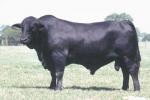
|
Brangus
|
|
The Brangus breed was developed to utilize the superior traits of Angus and Brahman cattle. Their genetics are stabilized at 3/8 Brahman and 5/8 Angus. The combination results in a breed which unites the traits of two highly successful parent breeds. |

|
Braunvieh
|
|
Braunvieh means "brown cattle" in German. Brown cattle found in the mountains of Switzerland during the 17th century formed the basis for the modern Braunvieh. They are gaining recognition as a breed for moderate frame, calving ease, excellent disposition, efficiency in the pasture and in the feedyard. |
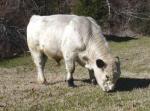
|
British White
|
|
The white cattle with the black points. The British White cow is of moderate size, 1000 to 1200 pounds. |
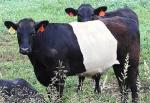
|
BueLingo
|
|
The BueLingo is a striking breed with it's white belt and black or cherry red forequarters and hindquarters. It is a moderate sized breed with female weighs between 1,000 and 1,200 pounds and bull weighs between 1,800 and 2,000 pounds. Birth weights typically vary between 65-80 pounds. Good carcass quality and modest marbling is accompanied by excellent taste. Fertility, desirable calving weights, vigorous calves with rapid maturation rates, excellent maternal instincts, and good dispositions are breed traits. |
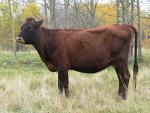
|
Canadienne
|
|
Canadienne cattle arrived in Quebec between 1608 and 1660. This was the first cattle breed to be developed in North America, primarily from animals imported from Normandy and Brittany. This stock was blended on this continent and selected for hardiness and productivity in the New World. |
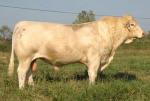
|
Charolais
|
|
Charolais cattle have changed beef production concepts almost as much as the original British breeds did in the American Southwest more than a century ago. They originated around Charolles in Central France. |
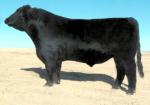
|
Chiangus
|
|
Chiangus were developed by blending the genetics of Chianina and Angus to produce a black, polled composite breed. The Chiangus registry program was adopted in 1976 by the ACA. |
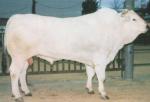
|
Chianina
|
|
Chianina are big cattle! Chianina (pronounced Kee-a-nee-na) is one of the oldest breeds of cattle in the world. Originating in Central Italy, Chianina were initially introduced into the United States in 1971, when the first Chianina semen was imported. The first Chianina born in the U.S. was a black half-blood Chianina X Angus/Holstein bull calf born on January 31, 1972. Beginning in 1975, Italian Fullblood Chianina were exported from Canada into this country. |
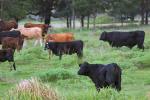
|
Commercial Cattle
|
|
Commercial cattle are any cattle that are not registered with a breed association. The great majority of cattle in the country are commercial. |
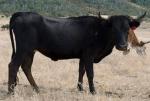
|
Corriente
|
|
The Corriente can be traced back to the first cattle brought to the new world by the Spanish as early as 1493. These cattle were hardy breeds chosen especially to withstand the ocean crossing and adapt to their new land. They were brought to the West Indies and south Florida, as well as to Central and South America. Over the centuries the descendants of these cattle were bred for different purposes - milk, meat and draft animals. |

|
Devon
|
|
The first Devon cattle reached what is now the United States in 1623. The ship Charity brought a consignment of red cattle (one bull and three heifers) from Devonshire, England to Edward Winslow, the agent for Plymouth Colony. |
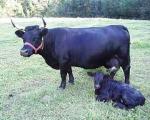
|
Dexter
|
|
Dexters are the smallest breed of cattle in America. They are dual purpose animals producing both delicious meat and quality milk. Cows mature to 750-800 lbs. and 36-42 inches high at the shoulder. Bulls mature to 1000-1100 lbs. and 38-44 inches high at the shoulder. They usually are black but can be dunn (a reddish brown shade). |
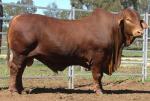
|
Droughtmaster
|
|
In order to breed and grow cattle in the heat and frequent droughts of Northern Queensland in Australia's hot tropical north several cattlemen set about crossing Zebu cattle (Bos indicus) with Shorthorn and Shorthorn/Devon. |
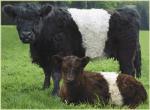
|
Galloway
|
|
The Galloway breed is small to medium framed. The hair is long, soft and wavy with a thick undercoat. The most common color is black, and there are also yellowish-gray to light brown animals. New-born calves are mahogany brown. |

|
Gelbvieh
|
|
Gelbvieh (say gelp-fee) originated in Bavaria, in southern Germany in the late 18th and early 19th century. They were first imported into the US in 1971. The classic color is yellow, but some are reddish or black, with light skin pigmentation and short horns. Polled cattle have developed in the United States from the use of naturally hornless foundation females. |
|
|